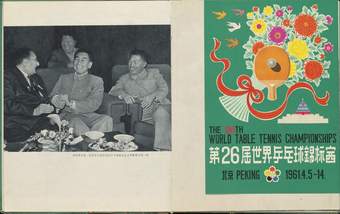12 rooms in Artist and Society
Explore photobooks published by the Chinese government from the 1950s to the 1980s that aimed to build international diplomacy
Years of devastating armed conflicts between the Chinese Communist Party and the government of the Republic of China ended in 1949 with Communist control of Mainland China. Mao Zedong, the Communist Party leader, declared the founding of the People’s Republic of China.
In the following decades, China sought to strengthen international relations with other countries. Mao and his government wanted to construct a new national identity and global image for China. Mao called this New China.
The Chinese Communist Party replaced private publishing houses with government-sanctioned bookmaking. These official publishers made books with images documenting religious expeditions and large-scale sports competitions. The photographers’ names and identities were not recorded, as these publications were intended to be the voice of the new nation, not any individual. The photobooks were distributed nationally and internationally, with captions translated into Arabic, English, Indonesian and Russian.
Mao’s portrait was on the first page of all official publications. Staged images of workers became extremely common. State publishers issued publications showing landscapes of large-scale infrastructure projects such as roads and waterworks, as well as the extraction of natural resources. Civil aviation books were published to study the movement of clouds, seeking to control the skies.
The name of this display is taken from the ancient Chinese concept of equal human unity with Heaven and Earth. This notion was adjusted in the era of New China to mean human governance over Heaven and Earth.
These books are drawn from the Martin Parr collection at Tate which comprises over 12,000 photobooks from around the world.

